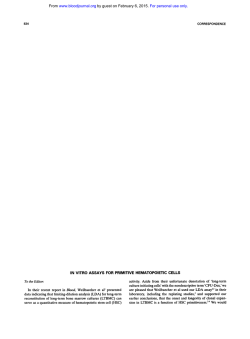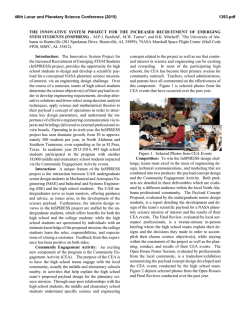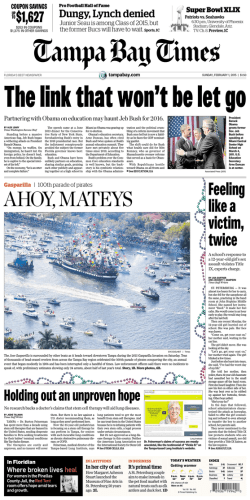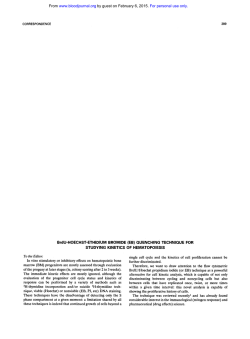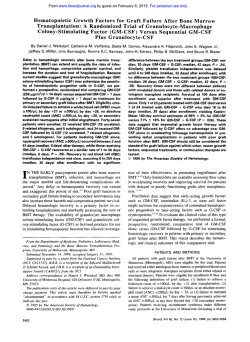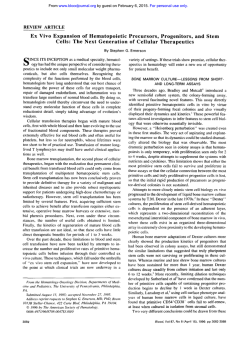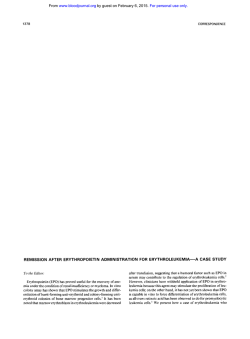
The Kinetics of Murine Hematopoietic Stem Cells In Vivo in
From www.bloodjournal.org by guest on February 6, 2015. For personal use only. The Kinetics of Murine Hematopoietic Stem Cells In Vivo in Response to Prolonged Increased Mature Blood Cell Production Induced by Granulocyte Colony-Stimulating Factor By Gerald de Haan, Bert Dontje, Christoph Engel, Markus Loeffler, and Willem Nijhof Because of the complexityof appropriate stem cell assays, little information on the in vivo regulation of murine stem cell biology or stemmatopoiesis is available. It is unknown whether and howin vivo the primitivehematopoietic stem cell compartment is affected during a continued increased production of mature blood cells. In thisstudy, we present data showing that prolonged (3 weeks) administration of granulocyte colony-stimulating factor (G-CSF), which is a major regulator of mature granulocyte production, has a substantial impact on both the size and the location of various stem cellsubset pools in mice. We have used the novel cobblestone area forming cell (CAFC) assay t o assess the effects of G-CSF on the stemcell compartment (CAFC days 7, 14, 21, and 28). In marrow, in which normally 99% of the total number of stem cells can be found, G-CSF induced a severe depletion of particularly the most primitive stem cells t o 5% t o 10% of normal values. The response after 7 days of G-CSF treatment was an increased amplification between CAFC day 14 and 7. However, this response occurred at the expense of the number of CAFC day 14. It is likely that the subsequently resulting gap of CAFC day 14 cell numbers was replenished from the more primitive CAFC day 21 and 28 compartments, because these cell numbers remained low during theentire treatment period. Inthe spleen, the number of stem cells increased, likely caused by a migration from the marrowvia the blood, leading t o an accumulationin the spleen. The increased number of stem cells in the spleen overcompensated for the loss in the marrow. When total body (marrow and spleen) stem cell numbers were calculated, it appeared that a continued increased production of mature granulocytesresulted in the establishmentof a higher, new steady state of the stem cell compartment; most committed stemcells (CAFC day 7) were increased threefold, CAFC day 14 were increased 2.3-fold, CAFC-day 21 were increased 1.8-fold, and the most primitive stem cells evaluated, CAFC day 28, were notdifferent from normal, although now 95% of these cells were located in the spleen. Four weeks after discontinuation of the G-CSF treatment, the stem cell reserve in the spleen had returned t o a normal level, whereas stem cell numbers in marrow hadrecovered t o values above normal. This study shows that the primitive stem cell Compartment is seriously perturbed during an increased stimulation of the productionof mature bloodcells. Furthermore, it shows that intricate regulatory feedback loops exist within the stem cell compartment that will enable proper adaptations t o stress situations. 0 1995 by The American Society of Hematology. G granulocyte production will not only affect granuloid cell stages, but also, given the intricate regulatory control processes of in vivo hematopoiesis, will influence other cell compartments. We have previously shown that in vivo GCSF-stimulated granulopoiesis inhibits erythropoie~is.~,’ It is conceivable that a prolonged increased production of granulocytes also has an impact on stem cells, because this may indirectly affect the cell flow out of the stem cell compartment. Therefore, it is surprising to see that little is known of the effects of a sustained, enhanced production of mature blood cells on the stem cell compartment. More generally, it is unknown howstem cell proliferation and differentiation, tentatively called stemmatopoiesis, is regulated andwhat role cytokines play in this process. This lack of knowledge has led to the logical concern as to whether stem cell exhaustion may occur when hematopoietic growth factors are administered to patients8 In a murine model it has beenshown that G-CSF and granulocyte-macrophage colony-stimulating factor (GM-CSF), administered during several cycles of cyclophosphamide therapy, significantly reduced marrow transplantation potential, indicating a reduced numberof stem cells.’ Cronkite et all0 have shown that 1 month after cessation of long-term (128 days) G-CSF treatment, marrow cells were less capable of rescuing lethally irradiated mice. One of the most studied effects of G-CSF on primitive cells is its ability to induce mobilization of stem cells in the blood for stem cell harvesting. These cells have been shown to consist of colony-forming units spleen (CFU-S),” but also more primitive, long-term repopulating ability cells (LTRA) are mobilized.’* It has not yet been determined whether increased peripheral blood stem cells reflect anoverproduction ofstem cells inmarrowandtheir subsequent release or RANULOCYTE colony-stimulating factor (G-CSF) is a prime regulator of in vivo granulopoiesis. This growth factor is now widely administered to patients who recover from chemotherapy or radiotherapy. It has been proven to be able to shorten the neutropenic period in these patients because it can increase the amplification of immature granuloid cells invivo.’ The mechanism of this increased amplification can probably be attributed to multiple actions. First, G-CSF may increase the cycling activity of granuloid progenitor cells by shortening their cell cycle Second, G-CSF may reduce the average transit time of the granuloid ~ompartment.~.~ Finally, G-CSF may prevent apoptosis of responsive granuloid cells.’ The exact contribution of each of these parameters in the regulation of in vivo granulocyte production has not yet been assessed. However, whateverthe mechanism may be, a prolonged increased From the Groningen Institute for Drug Studies, Department of Hematology, University of Groningen, Groningen, The Netherlands; and the Institute for Medical Informatics, Statistics and Epidemiology, University of Leipzig, Leipzig, Germany. Submitted January 23, 1995; accepted June 20, 1995. Supported by grantsof the Deutsche Forschungsgemeinschaji (Lo 342/5-1) and the Jan Cornelis de Cock Stichting. Address reprint requests toGeraldde Haan, PhD, Groningen Institute for Drug Studies, Department of Hematology, Bloemsingel IO, 9712 KZ Groningen, The Netherlands. The publication costs of this article were defrayed in part by page charge payment. This article must therefore be hereby marked “advertisement” in accordance with I8 U.S.C. section 1734 solely to indicate this fact. 0 1995 by The American Society of Hematology. 0006-4971/95/8608-0034$3.00/0 2986 Blood, Vol 86, No 8 (October 15). 1995: pp 2986-2992 From www.bloodjournal.org by guest on February 6, 2015. For personal use only. EFFECTSOFG-CSF 2987 ONSTEM CELLCOMPARTMENT whether the increased frequency in blood is accompanied by a decrease in marrow. In the present study we were interested to see if the murine stem cell compartment would be perturbed at all during a continued increased generation of mature blood cells and, if so, how the primitive hematopoietic cell population would adapt to such a chronic increased production. To determine the characteristics of the murine stem cell compartments, several techniques are available. The classic in vivo stem cell assays (CFU-S,I3 LTRA,I4 selfrenewal determinati~n,’~ and marrow repopulating ability [MRA]16),which often are more qualitative than quantitative, each measure a specific distinct stem cell compartment and are thereby very animal- and time-consuming and labor intensive. Recently, a novel, miniaturized in vitro stem cell assay, the cobblestone area forming cell (CAFC) assay, has been developed by Ploemacher et al.”.’* In several reports, the correlation between stem cell subsets as measured by the CAFC assay and the various in vivo stem cell assays has been shown to be very Because this assay now enables a detailed quantification of all stem cell subsets, we have used this method to assess if and how long-term administration of G-CSF affects the number of cells in bone marrow and spleen and thus in the total animal. MATERIALS AND METHODS Mice. In all experiments, female C57BlI6 mice 12 to 16 weeks old and weighing 20 to 25 g were used. Each data point in the figures was obtained by analyzing individually 3 to 5 mice. Administration of G-CSF. G-CSF (recombinant human; donated by Amgen, Thousand Oaks, CA) was appropriately diluted and administered by subcutaneously implanted osmotic mini pumps (type Alzet 1007D or 2002; Alza Corp, Palo Alto, CA) to avoid high variation in serum G-CSF levels. To test whether the implantation of the pump by itself affected hematologic values, we assessed the effect of a 7- and 14-day implantation of a pump filled with saline. No changes compared to normal, untreated mice were observed (data not shown). G-CSF was infused at a dose of 2.5 &day. This dose results in maximal peripheral blood granulocyte production in our hands. GCSF was administered for 7, 14, and 21 days. Preparation of bone marrow and spleen cells. Mice were killed at the times indicated and the spleen and one femur were prepared. Bone marrow cells were collected by flushing the femur three times with l mL of a-medium (GIBCO, Grand Island, NY) with a 25-G needle. Spleen cells were obtained by gently pressing the spleen through a stainless steel sieve and collecting the cells in 1 mL of cy-medium. Single cells were obtained by repeatedly flushingthe spleen cells through a 25-G needle. Calculating marrow, spleen, and total animal cellularity. Femur and spleen nucleated cell numbers were determined with a Coulter Counter (Coulter, Hialeah, FL). Total marrow cellularity was calculated with the assumption that a femur represents 6% of the total marrow, according to Chervenick et alZ3and Briganti et al.24Total animal hematopoietic cell numbers were subsequently calculated, as we have reported before:by adding total marrow cellularity and spleen cellularity. Thus, changes in femur and spleen cellularity are reflected in this calculation. CAFC assay. The CAFC assay was essentially performed as described by Ploemacher et al.17,‘8 This assay is based on a limiting dilution type long-term bone marrow culture. A stromal layer was grown in 96-well microtiter plates (Costar, Cambridge, MA) in Dulbecco’s modified Eagle’s medium (DMEM; GIBCO), 10% fetal calf serum, 5% horse serum, m o m hydrocortison, 3.3 mmoyL Lglutamine, 80 U/mL penicilin, 80 p g / d streptomycin, mom P-mercaptoethanol, 10 mmom HEPES, and 25 m o V L NaHC03. Instead of using fresh marrow cells as a source of the stromal layer, we used FMBD- 1 cells (a preadipocyte cell line derived from C57BU 6 mice), which have been reported byNeben et aiz5 to result in similar CAFC frequencies as fresh marrow. Furthermore, this cell line is used to determine CAFC frequencies in human marrow cell suspensions.26Stromal cell layers were allowed to grow confluently in 14 days. Stromal cell layers were overlaid with bone marrow or spleen cells in 6 dilutions, each dilution threefold apart. For the CAFC assay, the medium was switched to 20%horse serum. Normal cells, G-CSF-marrow cells, and G-CSF-spleen cells were overlayed in 81,000 + 27,000 ”+ 9,000 ”+ 3,000 + 1,000 333 celldwell dilution series. Normal spleen cells were overlaid in a 729,000 243,000 81,000 27,000 9,000 3,000 dilution series. Each dilution was plated 15-fold. Twice a week half of the medium in a well was replaced with fresh medium. To assay the entire stem cell spectrum, the appearance of cobblestone areas (colonies of at least 5 small nonrefractile cells, growing underneath the stromal layer) was evaluated at weekly intervals for 4 weeks. It has been extensively described that the frequency of CAFC day 7 exclusively correlates with CFU-G(E)M/CFU-S-day 7, CAFC day 14 correspond to CFU-S day 12, and CAFC day 28 coincide with cells that have L-. 18-22 -+ -+ -+ -+ -+ -+ The limiting dilution analysis to determine the actual CAFC frequency was performed as described by Ploemacher et al.17.18 In short, individual wells were scored for the presence or absence of a cobblestone area. The percentage of negative wells as a function of the number of cells per well overlaid was used to calculate the absolute frequency of the various stem cell subsets, using the maximum likelihood solution.27 RESULTS Assessing CAFC frequencies. CAFC frequencies were determined as explained in the Materials and Methods. Table 1 gives an example of the scoring procedure and illustrates how the number of marrow or spleen cells overlaid on the stromal cell layer must span a broad range to cover the frequencies of all CAFC subsets. Table 1. Illustration of CAFC Day-7 and Day-21 Frequency Estimation in Marrow andSpleen Cell Suspensions of a Mouse Treated With G-CSF for 14 Days No. of Cells Marrow Cells Scored at per Well Day 7 Marrow Cells Scored at Dav 21 81,000 27,000 9,000 3,000 1,000 333 Calculated CAFC frequency/W cells 0115 0115 0115 3115 7115 11/15 11/15 14/15 15115 15115 15115 15115 0115 0115 0115 0115 2115 7115 0115 1/15 9115 10115 14115 15/15 70.6 0.307 214.3 8.08 Spleen Cells Scored at Day 7 Spleen Cells Scored at Day 21 This table gives an example of how the frequency of the various CAFC subsets is assessed. For each cell dilution, 15 duplicate wells are scored. For each mouse, 180 wells have to be evaluated weekly (marrow, 6 x 15; + spleen, 6 x 15). Given are the number of negative wells for each dilution for a mouse treated with G-CSF for 14 days. Femur cellularity was 34 x 10‘. Spleen cellularity was 460.3 x lo6. From www.bloodjournal.org by guest on February 6, 2015. For personal use only. 2988 DE HAAN ET AL thousand8 thOU.and. A 8. 1 r, Io 2 a. .c. P 2 S* E gw g 36 Bz E B z '0 0 0 7 I4 days d OCSF l r u l n m l n o 7 l4 n &pd GCSF Mmrd oo 7 14 daVrofGC*hhd Effects of G-CSFadministration on CAFC day 7. CAFC day 7, the most mature stem cells, behaved oppositely in marrow and spleen. Seven to 14 days of G-CSF administration slightly reduced the number of this cell type in marrow but concomittantly strong increases in the spleen were observed (Fig 1A and B). However, the effects in both marrow and spleen were transient; mice that had been treated for 21 days restored the number of CAFC day 7 in marrow well above normal values, at the expense of splenic CAFC. When total animal CAFC day 7 numbers were calculated, a threefold increase per animal was found (Fig 1C). Effects of G-CSF administration on CAFC day 14. Seven and 14 days of G-CSF administration seriously depleted the number of CAFC day 14 cells in marrow (Fig 2A). In the spleen, an accumulation of CAFC day 14 could be shown (Fig 2B). However, continuation of the G-CSF treatment to 21 days again resulted in a reversal of the initial effects. In marrow, CAFC day 14 recovered to normalvalues at day 21, and in the spleen a decline of cells was found. The time course of total CAFC day 14 numbers differed from that of CAFC day 7 (Fig 2C). After 7 days of G-CSF treatment, a slight decrease of total CAFC day 14 numbers was obtained, but these cells seemed to reach a new steady state at 2.3-fold above normal after 2 and 3 weeks of treatment. Effects of G-CSF administration on CAFC day 21. In marrow, CAFC day21 cells were severely reduced at all Fig 1. The effect of G-CSF administration on CAFC day 7 in femur (A), spleen (B), and total animal (C). Data are shown as the mean 2 1 SEM. timepoints (Fig 3A). Toward the end of the treatment, a minor or beginning recovery was observed. In the spleen, strong increases of CAFC day 21 were found (Fig 3B). At 21 days of treatment, no reduction of spleen CAFC day 21 could be shown, which was in contrast to CAFC day 7 and 14. As a consequence, total CAFC day 21 cells were almost exclusively located in the spleen during the treatment. The general pattern of total CAFC day 21 cells was similar to that for CAFC day 14 cells (Fig 3C). However, 3 weeks of G-CSF treatment resulted in a 2.3-fold increase of total CAFC day 14, but total CAFC day 21 cell numbers increased only 1.%fold. Effects of G-CSFadministration on CAFC day 28. The most primitive stem cells we measured, CAFC day 28, were also continuously severely reduced in marrow (Fig 4A). The loss of marrow CAFC day 28 cell numbers was compensated after 14 and 21 days of G-CSF treatment by splenic increases (Fig 4B). Total CAFC day 28 numbers therefore initially were reduced to 60% of normal, but when the treatment was continued, this decline disappeared and normal cell numbers were restored (Fig 4C). Effects of G-CSFadministration on the ratio between various CAFC subsets in marrow and spleen. Because it was a major aim of this study to determine alterations in the amplification between the distinct stem cell subsets, the ratios of CAFC day 7/14, 14/21, and 21/28 were calculated for marrow and spleen. These ratios give an impression of B Fig 2. The effect of G-CSF administration on CAFC day14 in femur (A), spleen(B), and total animal (C). Data are shown as the mean ? l SEM. From www.bloodjournal.org by guest on February 6, 2015. For personal use only. EFFECTS OF G-CSF ON STEM CELL COMPARTMENT 2989 A 9 B Fig 3. The effect ofG-CSF administration on CAFC day 21 infemur (AI, spleen (B),and total animal (C). Data are shown as the mean r 1 SEM. changes in the amplification between the various cell compartments. Figure 5A and B shows the changes of these ratios in marrow and spleen during 3 weeks of G-CSF treatment. After 7 days, the ratio of CAFC day 7/14 wasincreased, both in the marrow and in the spleen. However, when the treatment was continued to 21 days, this ratio returned to normal values, but the ratio of CAFC day 14/21 in the marrow was now strongly increased. This phenomenon did not occur in the spleen. The CAFC day 21/28 ratio was hardly affected in the marrow or the spleen. Behavior of CAFC subsets in marrow and spleen after discontinuation of G-CSFtreatment. To determine whether the serious depletion of the earliest marrow stem cells was reversible, the recovery of all CAFC subsets after 14 days of G-CSF treatment was assessed. Figure 6A demonstrates that 4 weeks after G-CSF discontinuation all cell types had indeed recovered. In fact, an overshoot was observed as all subsets reached numbers between 150% to 250% of control values. In the spleen, all subsets returned to normal values at this time point (Fig 6B). DISCUSSION It was the aim of these experiments to determine if and how the primitive stem cell compartment would be affected by a continuous increased production of mature granulocytes. Our data provide a general insight into the adaptation K A m d o X B of the murine stem cell compartment to a sustained enhanced production of peripheral blood cells. Several major conclusions can be drawn from this study. First, it is evident that administration of G-CSF, which is generally considered to be a lineage-specific, late-acting growth factor, has substantial effects on both the size and the distribution of the primitive hematopoietic stem cell compartment. In marrow, in which normally 99% of total hematopoiesis takes place, G-CSF results in a severe loss of especially the most primitive stem cells. The initial adjustment of the primitive compartment in response to G-CSF is to increase the amplificationbetween CAFC day 7 and 14. The increased total number of CAFC day 7 presumably are required for the enhanced granulocyte production. In marrow, this occurs at the expense of the number of CAFC day 14. However, the decrease of CAFC day 14 numbers inmarrow is transient. Replenishment of this compartment, which probably is caused by an increased amplification between CAFC day 14 and 21 (evidenced by the increasing ratio towards the end of the treatment), occurs on its turn at the expense of CAFC day 21 and 28, which remain severely decreased during the treatment period. The decrease of marrow stem cells can probably be attributed to an increased amplification and concomittant differentiation in more committed cell stages, but also to a massive migration out of the marrow, via the blood, leading to an accumulation in the spleen. Although it has been shown h lo u s a d r C Fig 4. The effect ofG-CSF administration on C A E day 28 in femur (A), spleen (B), and total animal (Cl. Data are shown as the mean 1 SEM. * From www.bloodjournal.org by guest on February 6, 2015. For personal use only. 2990 DE HAAN ET AL A t 0' control 7 days G-CSF G-CSF 14 days 21 days G-CSF B - l11 4 +14/21 *21/28 observed. CAFC day 7 numbers in marrow increased to values well above normal after 21 days of treatment, which was accompanied by a sharp decline of splenic values. A similar effect was observed for CAFC day14 numbers. These cells recovered toward normal values in marrow and concomittantly a slight decrease in the level of splenic cells was seen. However, CAFC day 21 and 28 numbers hardly recovered in marrow and here splenic values remained increased. One may only speculate about the origin of the relationship between cells in these two organs and their fate. It is unknownwhether backmigration from the spleento the marrow exists. However, by whatever mechanism, the organism is able to balance the number of stem cells per total animal, irrespective of their location. This finding is reflected in the graphs showing the total number of cells. Although there are major differences between marrow and spleen stem cell content, a prolonged G-CSF treatment gradually resulted in a new steady state of the total stem cell compartment. To meet the increased demand of mature cells, total CAFC day 7 numbers were threefold increased, CAFC day 14 numbers 2.3-fold, CAFC day 21 numbers ]&fold, and CAFC day 28 numbers were not different from normal. We believe that the perturbation of the stem cell compartmentis induced byan indirect effect of G-CSF. In this 300% 'CAFC 0' control 7 days 14 GCSF G-CSF days 7 + C F C 14 YCAFC 21 *CAFC 28 I 21 days G-CSF Fig 5. The effect of G-CSF administration on the ratio between the numbers of CAFC day 7 and 14, C A R day 14 and 21, and CAFC day 21 and 28 in femur (A) and spleen (B). before that G-CSF and many other agents induce splenic hematopoiesis in mice,6.'* this has never been properly quantified for the most primitive stem cells. Our data suggest that the mobilization of stem cells by G-CSF is not due to an overproduction of stem cells in marrow, but rather is accompanied by a decreased marrow stem cell reserve. This finding is in agreement with the results of a study reported by Neben et a1" that show that optimal mobilization induced by cyclophophamide and short-term G-CSF treatment in mice is accompanied by reduced marrow stem cell numbers. In their study, G-CSF alone did not have any impact onmarrow stem cells, butitis likely that this discrepancy with our results can be attributed to their short-term (4 days) treatment period. It will be interesting to assess whether the improved mobilization observed by a combination of stem cell factor (SCF) and G-CSF is due to an increased production of primitive cells by SCF and their subsequent release by G-CSF.29 Interestingly, our data show that, although G-CSF is continuously administered, splenic stem cell numbers are not constantly increasing. An inverse relationship between the number of stem cells present in marrow and in spleen was 'CAFC 7 +cAFc 14 * W C 21 *CMC 28 c 42 Fig 6. The recovery of CAFC subreto in marrow (A) and spleen (B), after a 14 days of G-CSF administration. Data are shown as the percentage of control. From www.bloodjournal.org by guest on February 6, 2015. For personal use only. EFFECTS OF G-CSF ON STEM CELL COMPARTMENT concept, G-CSF acts on committed granuloid progenitor cells and all observed effects are indirect adaptations of primitive cells to be able to replenish and feed committed compartments. However, another possibility may be that G-CSF, apart from the effects on the granuloid progenitors, also directly stimulates early stem cells. Although G-CSF generally is regarded as a lineage-restricted growth factor, it has been shown that in vitro G-CSF is able to induce cycling activity of quiescent stem cells.30 Many topics for further research remain after this study. It will be interesting to determine directly the extent and direction of migration between marrow and spleen via the blood. Furthermore, an even longer administration period or administration of G-CSF to splenectomized mice may result in additional or different perturbations of the stem cells. In this study, we show that the effects of G-CSF on the stem cell compartment seem to be reversible, although 4 weeks after G-CSF administration stem cell numbers in marrow are still not normalized. It is of interest to assess the nature of this recovery: is replenishment of marrow cells achieved by backmigration from the spleen or is it established by the remaining marrow stem cells? Finally, the question remains as to how these data can be extrapolated to the human situation. Because the CAFC assay has recently been adapted to measure human stem cell subsets,26more information on the dynamics of the human primitive compartment can be expected to be published in the near future. This information will be essential to test the safety but also optimize the efficacy of the use of growth factors in the clinic. ACKNOWLEDGMENT The authors thank Dr R. Ploemacher for advise and assistance on the CAFC assay and Dr S. Neben for providing the FBMD-1 cells. REFERENCES 1. Demetri GD, Griffin JD:Granulocyte colony-stimulating factor and its receptor. Blood 78:2791, 1991 2. Broxmeyer HE, Benninger L, Pate1 SR, Benjamin RS, VadhanRaj S: Kinetic response of human marrow myeloid progenitor cells to in vivo treatment with G-CSF is different from the response to treatment with GM-CSF. Exp Hematol 22:100, 1994 3. Lord BI, Bronchud MH, Owens S, Chang J, Howell A, Souza L, Dexter TM: The kinetics of human granulopoiesis following treatment with granulocyte colony-stimulating factor in vivo. Proc Natl Acad Sci USA 86:9499, 1989 4. Lord BI, Molineux G, Pojda Z, Souza LM, Mermod JJ, Dexter "M: Myeloid cell kinetics in mice treated with recombinant interleukin-3, granulocyte colony-stimulating factor (CSF) or granulocytemacrophage CSF in vivo. Blood 77:2154, 1991 5 . Williams GT, Smith CA, Spooncer E, Dexter TM, Taylor DR: Haemopoietic colony stimulating factors promote cell survival by suppressing apoptosis. Nature 343:76, 1990 6. de Haan G, Loeffler M, Nijhof W: Long-term recombinant human granulocyte colony-stimulating factor (rhG-CSF) treatment severely depresses murine marrow erythropoiesis without causing an anemia. Exp Hematol 20:600, 1992 7. de Haan G, Engel C, Dontje B, Nijhof W, Loeffler M: The mutual inhibition of murine erythropoiesis and granulopoiesis during combined erythropoietin, granulocyte colony-stimulating factor and stem cell factor administration: In vivo interactions and dose response surfaces. Blood 84:4157, 1994 2991 8. Moore MAS: Does stem cells exhaustion result from combining hematopoietic growth factor therapy with chemotherapy. If SO, how do we prevent it? Blood 803, 1992 9. Homung R L , Longo DL: Hematopoietic stem cell depletion by restorative growth factor regimens during repeated high dose cyclophosphamide therapy. Blood 80:77, 1992 10. Cronkite EP, Burlington H, Shimosaka A, Bullis JE, Pappas N: Anemia induced in splenectomized mice by administration of rhG-CSF. Exp Hematol 21:319, 1993 11. Bungart B, Loeffler M, Goris H, Dontje B, Diehl V, Nijhof W: Differential effects of recombinant human granulocyte colonystimulating factor (rhG-CSF) on stem cells in marrow, spleen and peripheral blood in mice. Br J Haematol 76:174, 1990 12. Molineux G, Pojda Z, Hampson IN, Lord BI, Dexter TM: Transplantation potential of peripheral blood stem cells induced by granulocyte colony-stimulating factor. Blood 76:2153, 1990 13. Till JE, McCulloch EA: A direct measurement of radiation sensitivity of normal mouse bone marrow cells. Radiat Res 14:213, 1961 14. Harrison DE: Competitive repopulation: A new assay for longterm stem cell functional capacity. Blood 55:77, 1980 15. Hellman S, Botnick LF, Hannon EC, Vigneulle RM: Proliferative capacity of murine hematopoietic stem cells. Proc Natl Acad Sci USA 75:490, 1978 16. Hodgson GS, Bradley T R Properties of haematopoietic stem cells surviving 5-fluorouracil treatment: Evidence for a pre-CFU-S cell? Nature 281:381, 1979 17. Ploemacher RE, Van der Sluijs JP, Voerman JSA, Brons NHC: An in vitro limiting-dilution assay of long-term repopulating hematopoietic stem cells in the mouse. Blood 74:2755, 1989 18. Ploemacher R E , Van der Sluijs JP, Van Beurden CAJ, Baert MRM, Chan PL: Use of limiting-dilution type long-term bone marrow cultures in frequency analysis of marrow-repopulating and spleen colony-forming hemopoietic cells in the mouse. Blood 78:2527, 1991 19. Ploemacher RE, van der Loo JCM, van Beurden CM, Baert MRM: Wheat germ agglutinin affinity of murine hemopoietic stem cell subpopulations is an inverse function of their long-term repopulating ability in vitro and in vivo. Leukemia 7:120, 1993 20. Down JD, Ploemacher RE: Transient and permanent engraftment potential of murine hematopoietic stem cell subsets: Differential effects of host conditioning with gamma radiation and cytotoxic drugs. Exp Hematol 21:913, 1993 2 1. Neben S, Marcus K, Mauch P: Mobilization of hematopoietic stem and progenitor cell subpopulations from the marrow to the blood of mice following cyclophosphamide and/or granulocyte colony-stimulating factor. Blood 8 1:1960, 1993 22. Neben S, Anklesaria P, Greenberger J, Mauch P: Quantitation of murine hematopoietic stem cells in vitro by limiting dilution analysis of cobblestone area formation on a clonal stromal cell line. Exp Hematol 21:438, 1993 23. Chervenick PA, Boggs DR, Marsh JC, Cartwright GE, Wintrobe MM: Quantitative studies of blood and bone marrow neutrophils in normal mice. Am J Physiol 215353, 1968 24. Briganti G, Covelli V, Silini G, Srivastava PN: The distributionof erythropoietic bone marrow in the mouse. Acta Haematol 44:355, 1970 25. Neben S, Donaldson D, Sieff C, Mauch P, Bodine D, Ferrara J, Yetz-Aldape J, Turner K: Synergistic effects of interleukin-l 1 with other growth factors on the expansion of murine hematopoietic progenitors and maintenance of stem cells in liquid culture. Exp Hematol 22:353, 1994 26. Breems DA, Blokland EAW, Neben S, Ploemacher R: Frequency analysis of human primitive haematopoietic stem cell subsets using a cobblestone area forming cell assay. Leukemia 8:1095, 1994 From www.bloodjournal.org by guest on February 6, 2015. For personal use only. 2992 27. Fazekas de St Groth S:The evaluation of the limiting dilution assays. J Immunol Methods 49:Rll, 1982 28. Molineux G, Pojda Z, Dexter TM: A comparison of hematopoiesis in normal and splenectomized mice treated with granulocye colony-stimulating factor. Blood 75563, 1990 29. Bride11 RA, Hartley CA, Smith KA, McNiece I K Recombinant rat stem cell factor synergizes with recombinant human granulo- DE HAAN ET AL cyte colony-stimulating factor in vivo in mice to mobilize peripheral blood progenitor cells that have enhanced repopulating potential. Blood 82:1720, 1993 30. Ikebuchi K, Clark SC, Ihle JN, Souza LM, Ogawa M: Granulocyte colony-stimulating factor enhances interleukin-3 dependent proliferation of multipotential hemopoietic progenitors. h o c Natl Acad Sci USA 85:3445, 1988 From www.bloodjournal.org by guest on February 6, 2015. For personal use only. 1995 86: 2986-2992 The kinetics of murine hematopoietic stem cells in vivo in response to prolonged increased mature blood cell production induced by granulocyte colony-stimulating factor G de Haan, B Dontje, C Engel, M Loeffler and W Nijhof Updated information and services can be found at: http://www.bloodjournal.org/content/86/8/2986.full.html Articles on similar topics can be found in the following Blood collections Information about reproducing this article in parts or in its entirety may be found online at: http://www.bloodjournal.org/site/misc/rights.xhtml#repub_requests Information about ordering reprints may be found online at: http://www.bloodjournal.org/site/misc/rights.xhtml#reprints Information about subscriptions and ASH membership may be found online at: http://www.bloodjournal.org/site/subscriptions/index.xhtml Blood (print ISSN 0006-4971, online ISSN 1528-0020), is published weekly by the American Society of Hematology, 2021 L St, NW, Suite 900, Washington DC 20036. Copyright 2011 by The American Society of Hematology; all rights reserved.
© Copyright 2026
